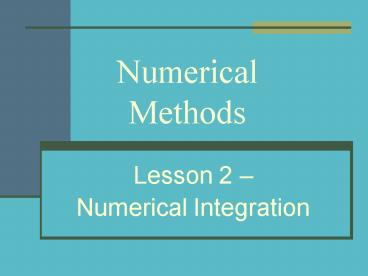Numerical Methods PowerPoint PPT Presentation
1 / 18
Title: Numerical Methods
1
Numerical Methods
- Lesson 2
- Numerical Integration
2
Mid-Point Trapezium
- There is a link between the mid-point rule and
the trapezium rule. - Given by the formula
- Prove the following
3
Mid-Point Trapezium
4
Upper and Lower bounds
- Lets look at a general curve y f(x).
- You can see that the curve is concave in this
example - We want to estimate the area between two bounds a
b.
- If we use T1 we can clearly see that the
approximation will be an over estimate. - Now lets look what would happen if we use M1.
- Its difficult to see what is happening here so
lets look at the area in a different way. - We can change the area to a trapezium by cutting
of a triangle. - Here we can see that the approximation is an
under estimate.
5
Upper and Lower bounds
- Now lets add back in to the diagram the
approximation for T1. - From this you can see that the Trapezium rule is
an over estimate for the area and the midpoint
rule is an under estimate. - That is
- Draw a similar diagram to show that if f(x) is
convex then
6
Upper and Lower bounds
- In fact for most well behaved functions, this
will also apply to Tn Mn. - This is important for two reasons.
- i) It is possible to produce upper and lower
bounds for the exact area. - (this means that we can give the area to a
specified degree of accuracy) - ii) It leads to the development of another
method for approximating area. - This is known as Simpsons rule.
7
Upper and Lower bounds
- In fact with the example we have looked at in
lesson 1 Mn remains an over estimate and Tn an
under estimate. - From the table below it is clear that using M32
T32 gives us an estimate for the area correct to
3 d.p.
8
Different Example
- Given that
- a) Use the trapezium rule with 3 interval to
estimate I. - b) Evaluate I exactly using integration.
- c) Can you explain why you have got the
results shown in parts a) b).
- Answers
- a) 45 units2.
- b) 45 units2.
- c)
9
Simpsons Rule
- Lets look again at the question we looked at in
Lesson 1. - If we calculate the exact value of this integral
we get 0.913 986 to 6 d.p. - Here again are the estimates that we calculated
in lesson 1.
10
Simpsons Rule
- As we have discussed already in this example the
Mid-point gives an over estimate and the
Trapezium rule gives an under estimate. - Next lets look at the absolute error in each
estimation. - First thing to notice is that the error quarters
each time you double the intervals. - (This concept will be useful in your coursework).
11
Simpsons Rule
- The second thing to notice is that the absolute
error for T1 is roughly twice as big as the
absolute error for M1. - In fact this is true for all Tn Mn.
- This concept can be shown on a number line.
12
Simpsons Rule
- This weighted result is the basis for Simpsons
rule. - Simpsons rule takes into account that the actual
value of the area is twice as close to Mn as it
is to Tn. - Simpsons rule is calculated by using the
following weighted formula.
13
Simpsons Rule
- Lets look again at the number line for T1 M1.
- If you take the mean of these two values you can
see that is not that close to the actual value. - However if we use Simpsons rule we can see that
Sn is a far better approximation.
14
Simpsons Rule
- Also if we look at the diagrams from the start of
the lesson we can also see that the Mid-point
rule estimate is closer to the real answer than
the Trapezium rule estimate.
15
Question
- Use Simpsons rule to calculate the values of S1,
S2, S4, S8 for the example.
16
Simpsons Rule
- Simpsons rule approximation can be calculated
directly from f(x). - The Trapezium rule uses n strips and evaluates
f(x) on the edge of those intervals. - The Mid-point rule uses n strips and evaluates
f(x) in the middle of each interval. - As Simpsons rule uses both of the above it must
be evaluated with 2n strips. - When you use Simpsons rule divide the interval
up in to 2n strips and label from the left hand
of the first strip to the right hand of the last
strip. - Using f0, f1,, f2n, we have
17
Example
- Find S4 for
18
Question
- Find to 6 decimal places, the approximations S1,
S2, S4 for the integral

